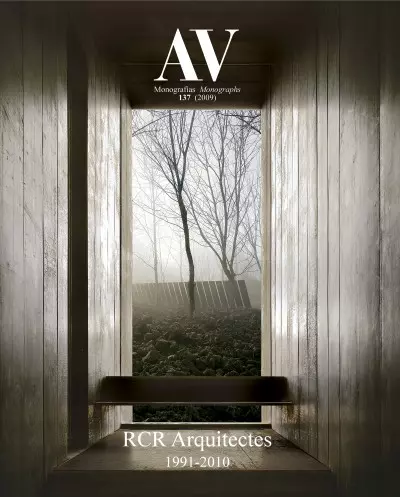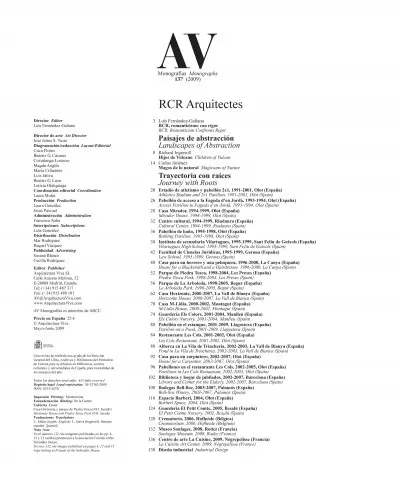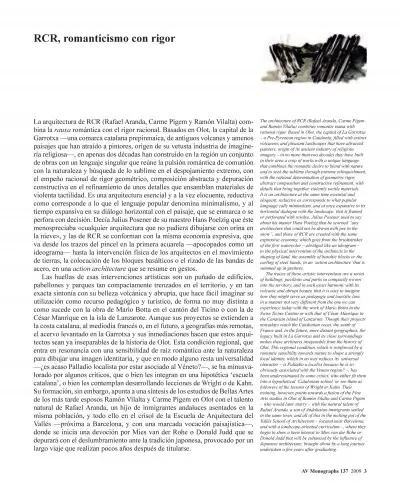RCR Arquitectes
Luis Fernández-Galiano
RCR, romanticismo con rigor
RCR, Romanticism Confronts Rigor
Paisajes de abstracción
Landscapes of Abstraction
Richard Ingersoll
Hijos de Vulcano Children of Vulcan
Carlos Jiménez
Magos de lo natural Magicians of Nature
Trayectoria con raíces
Journey with Roots
Estadio de atletismo y pabellón 2x1, 1991-2001, Olot (España)
Athletics Stadium and 2x1 Pavilion, 1991-2001, Olot (Spain)
Pabellón de acceso a la Fageda d’en Jordà, 1993-1994, Olot (España)
Access Pavilion to Fageda d’en Jordà, 1993-1994, Olot (Spain)
Casa Mirador, 1994-1999, Olot (España)?
Mirador House, 1994-1999, Olot (Spain)
Centro cultural, 1994-1999, Riudaura (España)?
Cultural Center, 1994-1999, Riudaura (Spain)
Pabellón de baño, 1995-1998, Olot (España)?
Bathing Pavilion, 1995-1998, Olot (Spain)
Instituto de secundaria Vilartagues, 1995-1999, Sant Feliu de Guíxols (España)?
Vilartagues High School, 1995-1999, Sant Feliu de Guíxols (Spain)
Facultad de Ciencias Jurídicas, 1995-1999, Gerona (España)?
Law School, 1995-1999, Gerona (Spain)
Casa para un herrero y una peluquera, 1996-2000, La Canya (España)?
House for a Blacksmith and a Hairdresser, 1996-2000, La Canya (Spain)
Parque de Piedra Tosca, 1998-2004, Les Preses (España)?
Piedra Tosca Park, 1998-2004, Les Preses (Spain)
Parque de La Arboleda, 1998-2005, Begur (España)?
La Arboleda Park, 1998-2005, Begur (Spain)
Casa Horizonte, 2000-2007, La Vall de Bianya (España)?
Horizonte House, 2000-2007, La Vall de Bianya (Spain)
Casa M-Lidia, 2000-2002, Montagut (España)?
M-Lidia House, 2000-2002, Montagut (Spain)
Guardería Els Colors, 2001-2004, Manlleu (España)?
Els Colors Nursery, 2001-2004, Manlleu (Spain)
Pabellón en el estanque, 2001-2009, Llagostera (España)
Pavilion on a Pond, 2001-2009, Llagostera (Spain)
Restaurante Les Cols, 2001-2002, Olot (España)?
Les Cols Restaurant, 2001-2002, Olot (Spain)
Alberca en La Vila de Trincheria, 2002-2003, La Vall de Bianya (España)?
Pond in La Vila de Trincheria, 2002-2003, La Vall de Bianya (Spain)
Casa para un carpintero, 2002-2007, Olot (España)?
House for a Carpenter, 2002-2007, Olot (Spain)
Pabellones en el restaurante Les Cols, 2002-2005, Olot (España)?
Pavilions in Les Cols Restaurant, 2002-2005, Olot (Spain)
Biblioteca y hogar de jubilados, 2002-2007, Barcelona (España)?
Library and Center for the Elderly, 2002-2007, Barcelona (Spain)
Bodegas Bell-lloc, 2003-2007, Palamós (España)?
Bell-lloc Winery, 2003-2007, Palamós (Spain)
Espacio Barberí, 2004, Olot (España)?
Barberí Space, 2004, Olot (Spain)
Guardería El Petit Comte, 2005, Besalú (España)?
El Petit Comte Nursery, 2005, Besalú (Spain)
Crematorio, 2006, Hofheide (Bélgica)?
Crematorium, 2006, Hofheide (Belgium)
Museo Soulages, 2008, Rodez (Francia)?
Soulages Museum, 2008, Rodez (France)
Centro de arte La Cuisine, 2009, Nègrepelisse (Francia)?
La Cuisine Art Center, 2009, Nègrepelisse (France)
Diseño industrial?Industrial Design
Luis Fernández-Galiano
RCR, Romanticism Confronts Rigor
The architecture of RCR (Rafael Aranda, Carme Pigem and Ramón Vilalta) combines romantic rauxa with rational rigor. Based in Olot, the capital of La Garrotxa – a Pre-Pyrenean region in Catalonia, filled with extinct volcanoes and pleasant landscapes that have attracted painters, origin of its ancient industry of religious imagery – in no more than two decades they have built in their area a crop of works with a unique language that combines the romantic desire to blend with nature and to seek the sublime through extreme relinquishment, with the rational determination of geometric rigor, abstract composition and constructive refinement, with details that bring together violently tactile materials. It is an architecture at the same time essential and eloquent, reductive as corresponds to what popular language calls minimalism, and at once expansive in its horizontal dialogue with the landscape, that is framed or perforated with resolve. Julius Posener used to say about his master Hans Poelzig that he scorned “any architecture that could not be drawn with pee in the snow”, and those of RCR are created with the same expressive economy, which goes from the brushstrokes of the first watercolor – abridged like an ideogram – to the physical intervention of the architects in the shaping of land, the assembly of basaltic blocks or the curling of steel bands, in an ‘action architecture’ that is summed up in gestures.
The traces of these artistic interventions are a series of buildings, pavilions and parks so compactly woven into the territory, and in such exact harmony with its volcanic and abrupt beauty, that it is easy to imagine how they might serve as pedagogic and touristic lure, in a manner not very different from the one we can experience today with the work of Mario Botta in the Swiss Ticino Canton or with that of César Manrique in the Canarian island of Lanzarote. Though their projects nowadays reach the Catalonian coast, the south of France and, in the future, more distant geographies, the legacy built in La Garrotxa and its close surroundings makes these architects inseparable from the history of Olot. This regional condition, which is reinforced by a romantic sensibility towards nature to shape a strongly local identity, which in no way reduces its universal character – is Palladio a localist because he is so obviously associated with the Veneto region? –, has been underestimated by some critics, who either fit them into a hypothetical ‘Catalonian school’ or see them as followers of the lessons of Wright or Kahn. Their training, however, points towards a fusion of the Fine Arts studies in Olot of Ramón Vilalta and Carme Pigem – who would later marry – with the natural talent of Rafael Aranda, a son of Andalusian immigrants settled in the same town, and all of this in the melting pot of the Vallés School of Architecture – located near Barcelona, and with a landscape-oriented curriculum –, where they begin to show a keen interest in Mies van der Rohe or Donald Judd that will be enhanced by the influence of Japanese architecture, brought about by a long journey undertaken a few years after graduating.








